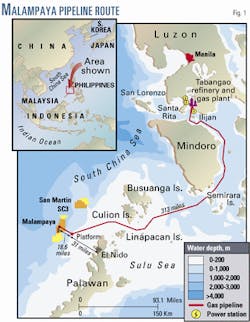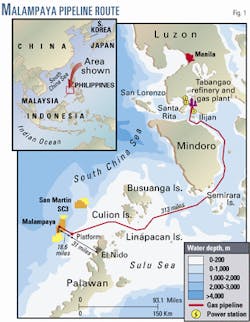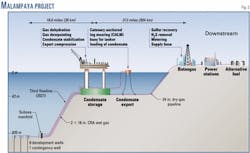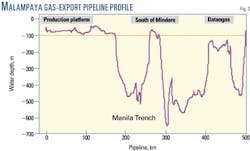First commercial sales flow from Malampaya gas plant, pipelines
Gas sales began this month from the Malampaya project, offshore Philippines, to electric power generators on the main island of Luzon.
Since Oct. 1, 2001, gas for power plant commissioning has been flowing from the gas plant at Batangas, to its downstream buyers, the Ilijan, Santa Rita, and San Lorenzo power plants.
Critical for the project´s delivery of deepwater-produced gas to the nation is the system of nearly 330 miles of flowlines and pipelines laid over rugged sea floor topography and through seismically active and environmentally sensitive areas (Fig. 1).
David J. Greer, managing director for project operator Shell Philippines Exploration BV, discussed the project´s pipelines in a presentation to the 18th World Energy Congress in Buenos Aires in October 2001.
Project profile
The upstream Malampaya development plan calls for nine subsea gas wells connected to subsea manifolds on the seabed over Malampaya at a water depth of approximately 850 m (Fig. 2).
Beginning in February 2000, five wells have been drilled initially to ensure delivery of commissioning gas on Oct. 1, 2001, and first commercial gas sales on Jan. 1, 2002. These first five wells are clustered around a subsea manifold between the Malampaya-1 and Malampaya-4 wells.
Drilling of the subsequent four wells is planned for 2009 and may involve a second manifold near the Camago area. Two of these four wells could be drilled from the initial northern manifold, said Greer, while the two other wells may be tied back from a southern manifold, targeting the Camago area of the accumulation.
Plans for the number and phasing of wells for the second phase of reservoir development will be subject to reservoir performance during early years of production, said Greer. The wells will be of a 7-in. monobore design with horizontal christmas trees, providing high production capacities with a simplified design for long service life.
The wells have permanent downhole gauges accurately to monitor reservoir performance and facilitate effective reservoir management.
The wells are tied-back to a production platform through two 18.6 mile, 16-in. corrosion resistant alloy-clad flowlines. The platform and associated storage and loading facilities are on the NW Palawan Shelf, some 31 miles west of Palawan Island and 248 miles southwest of Luzon Island in water 43 m deep.
Produced water and condensate are separated and treated on the platform. Condensate is stabilized to meet storage and transport requirements. The platform has a concrete gravity substructure with condensate storage in its base. Condensate is exported via shuttle tankers, which connects to a catenary anchored leg mooring offshore loading system, approximately every 2 weeks.
Wet gas is de-hydrated and dew point controlled at the platform. Dry gas is compressed and exported from the facility through a 313 mile, 24-in. carbon steel gas-export line to the gas plant site ashore at the Shell refinery at Tabangao, Batangas, on Luzon. There, H2S is being removed and the dry gas treated to buyers´ quality specifications.
Maintaining sufficient deliverability capacity from the field will require additional compression around 2015, said Greer, and installation of an additional 16-in. flowline from the subsea manifold to the platform in 2020 to reduce flowline back pressure and wellhead pressures.
The last stage of development before abandonment will consist of re-wheeling the compressors to accommodate lower suction pressure.
Pipelines
Greer said the field flowline and gas-export pipeline route selection, design, and installation are "at the forefront of deep water pipeline technology." The pipelines traverse structurally complex terrain with varied seabed characteristics and sea bottom relief. Fig. 3 shows a compressed profile of the route illustrating the varied relief, from the subsea manifold to the landing site at Batangas.
The Philippine archipelago is one of the most seismically active areas in the world, said Greer. The gas-export pipeline crosses active faults, an extensive system of submarine channels, and areas susceptible to mass gravity flows and other soil instabilities.
In addition, the route was selected to avoid environmentally sensitive areas such as coral reefs and pearl farms. It was surveyed in several extensive offshore campaigns to gather geophysical, geotechnical, environmental, and metocean design data.
Advanced satellite technology and computer visualization tools allowed the project team to make rapid and informed routing selections and decisions, said Greer. An environmental consultant was involved at an early stage to ensure all potential environmental concerns were identified, eliminated, or mitigated.
Allseas´ dynamically positioned lay ship Solitaire installed the pipeline precisely along the seabed route with minimal disturbance to the seabed.
A specialist group, working as part of the pipelines design team, systematically addressed seismic hazards within a limit-state design framework. A seismic hazard analysis was commissioned to provide seismic design criteria such as fault locations, displacements, and ground movements.
Greer said a separate mass gravity flow study investigated the likely pipeline loading as a consequence of submarine gravity slides. Finite-element models of soil behavior and pipeline response were developed to validate the design.
Greer concluded his remarks by pointing out the strategic fit of the Malampaya field facilities with the proposed Trans-Asean gas pipeline (Fig. 4).




